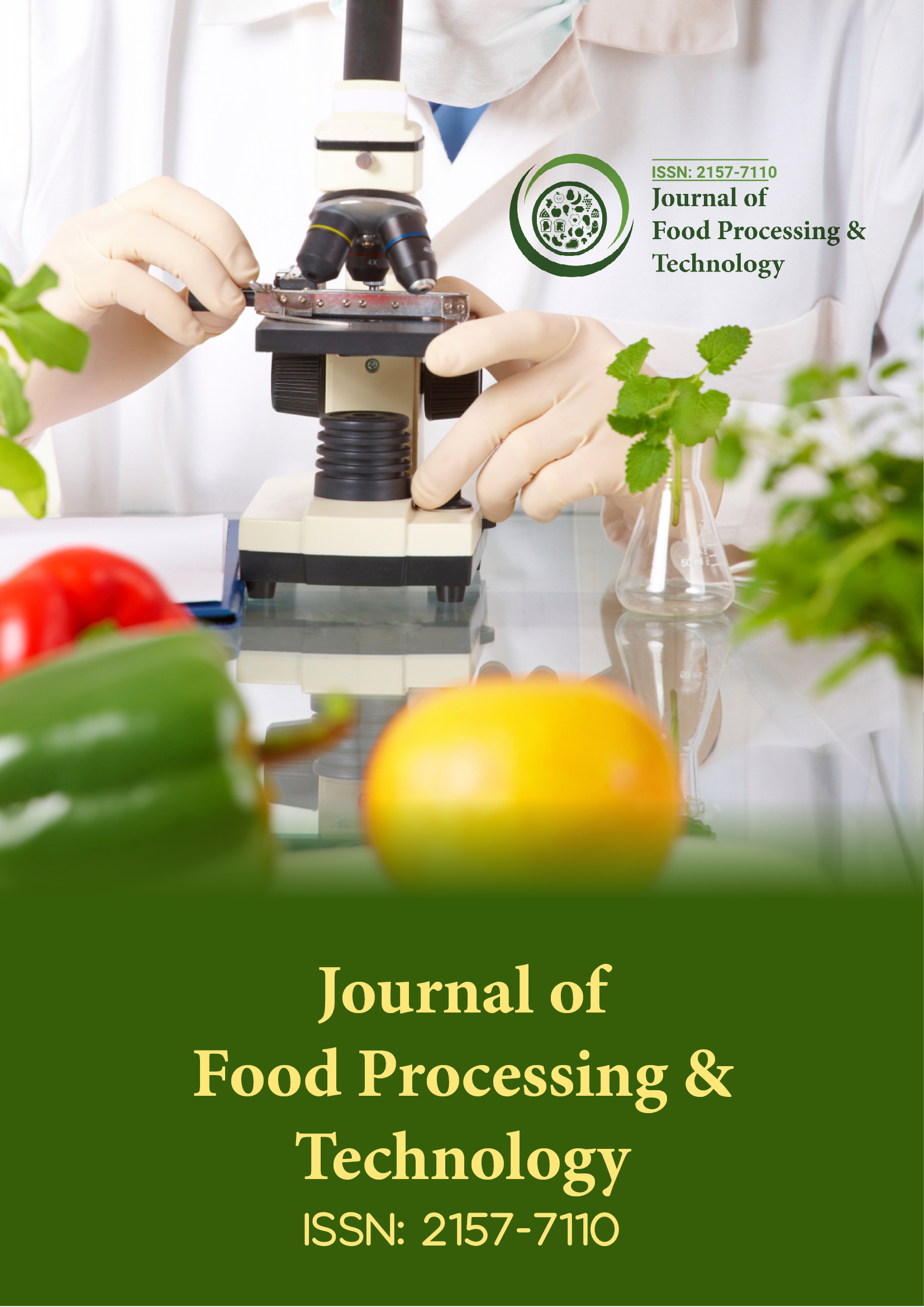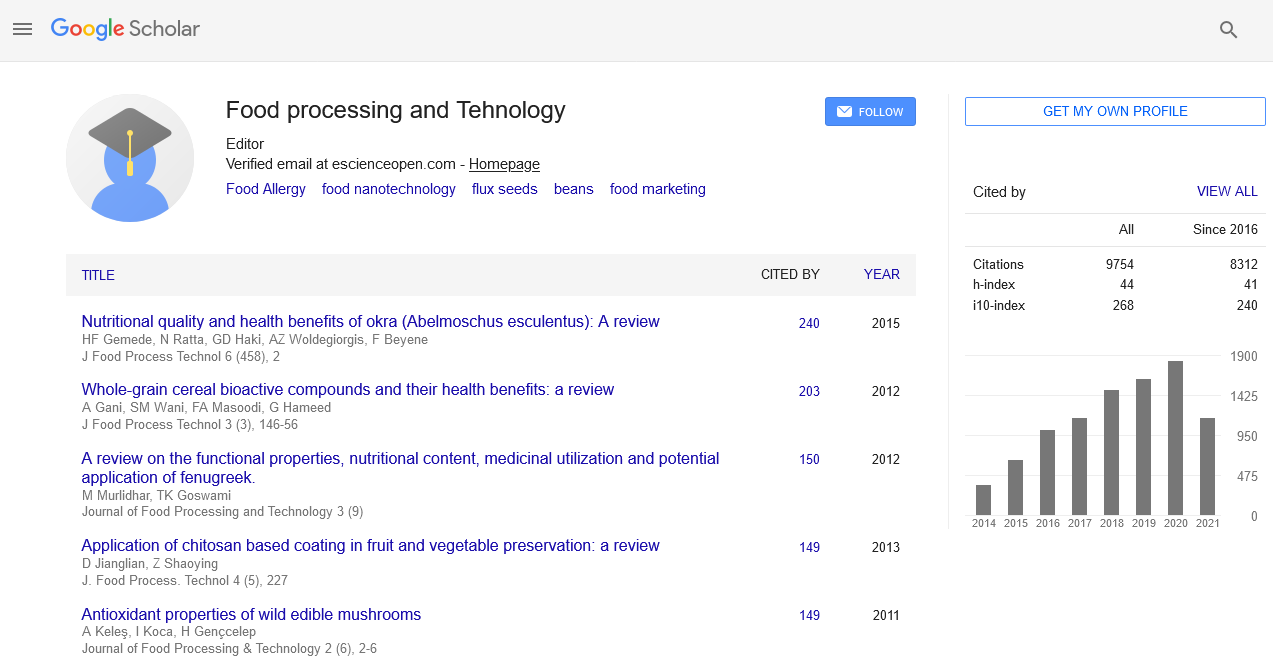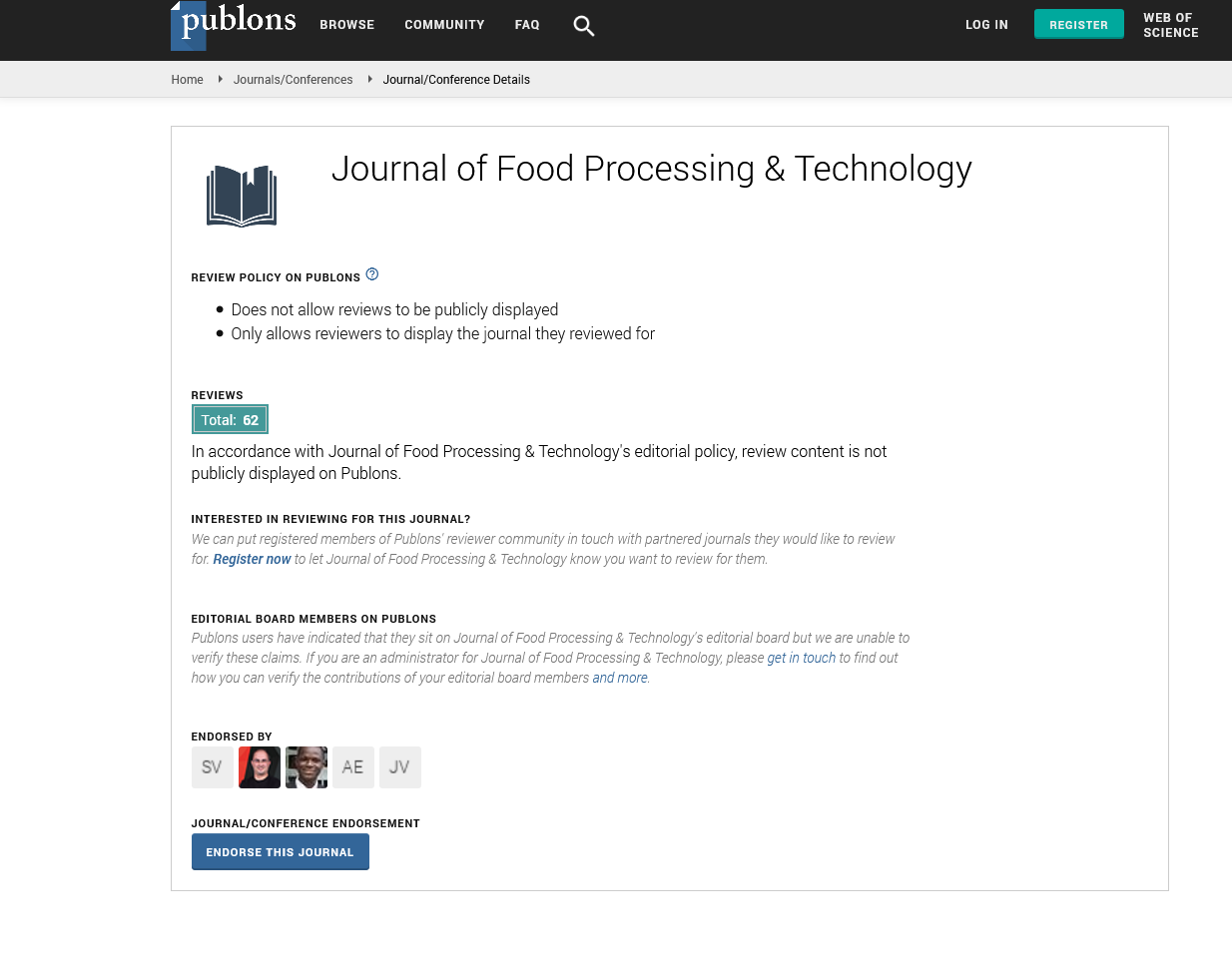Indexed In
- Genamics JournalSeek
- Academic Keys
- JournalTOCs
- China National Knowledge Infrastructure (CNKI)
- Access to Global Online Research in Agriculture (AGORA)
- Centre for Agriculture and Biosciences International (CABI)
- RefSeek
- Directory of Research Journal Indexing (DRJI)
- Hamdard University
- EBSCO A-Z
- OCLC- WorldCat
- Scholarsteer
- SWB online catalog
- Publons
- Euro Pub
- Google Scholar
Useful Links
Share This Page
Journal Flyer

Open Access Journals
- Agri and Aquaculture
- Biochemistry
- Bioinformatics & Systems Biology
- Business & Management
- Chemistry
- Clinical Sciences
- Engineering
- Food & Nutrition
- General Science
- Genetics & Molecular Biology
- Immunology & Microbiology
- Medical Sciences
- Neuroscience & Psychology
- Nursing & Health Care
- Pharmaceutical Sciences
Perspective - (2025) Volume 16, Issue 1
Microwave-Assisted Drying Techniques for Enhanced Food Quality
Ahmet Yildiz*Received: 27-Jan-2025, Manuscript No. JFPT-25-29169; Editor assigned: 29-Jan-2025, Pre QC No. JFPT-25-29169; Reviewed: 12-Feb-2025, QC No. JFPT-25-29169; Revised: 18-Feb-2025, Manuscript No. JFPT-25-29169; Published: 26-Feb-2025, DOI: 10.35248/2157-7110.25.16.1142
Description
Microwave assisted drying has emerged as a revolutionary technique in the food processing industry, offering a highly efficient and quality preserving alternative to traditional drying methods. The growing demand for minimally processed, high quality food products with retained nutritional and sensory attributes has led to the adoption of advanced drying technologies that can overcome the limitations of conventional approaches. Among these, microwave assisted drying stands out due to its rapid heating capability, energy efficiency and ability to enhance product quality by minimizing thermal degradation.
This technique combines the benefits of microwave energy with other drying methods, such as convective hot air or vacuum drying, to achieve optimal drying performance and preserve the integrity of food products. Microwave assisted drying operates by generating electromagnetic waves at a frequency typically around 2450 MHz, which penetrate deep into the food material. These waves cause polar molecules, particularly water, to oscillate rapidly, generating internal heat through molecular friction.
Unlike conventional surface heating methods that transfer heat from the exterior to the interior, microwave energy heats the product volumetrically. This internal heating mechanism results in a faster and more uniform drying process, reducing overall drying time and preventing overheating of the food surface. As a result, microwave assisted drying is particularly effective for high moisture content foods such as fruits, vegetables, herbs, meats and seafood.
One of the major advantages of microwave-assisted drying is the preservation of nutritional quality. Conventional drying methods, such as hot air or sun drying, often involve prolonged exposure to high temperatures, leading to the degradation of heat sensitive nutrients like vitamin C, B-complex vitamins and polyphenols. In contrast, the rapid and uniform heating in microwave drying significantly reduces drying time and lowers the risk of nutrient loss. Studies have shown that microwave-dried fruits and vegetables retain higher levels of antioxidants, vitamins and phenolic compounds compared to those dried using traditional methods.
Furthermore, the reduced exposure to oxygen and light during microwave drying helps in preserving the natural color and flavor of the food, making the final product more appealing to consumers. In addition to preserving nutrients, microwave assisted drying also contributes to the improvement of textural and rehydration properties of dried foods. The rapid evaporation of moisture from within the food matrix creates a porous structure, which enhances water absorption during rehydration. This is particularly beneficial for products like dried mushrooms, carrots and leafy vegetables, where rapid and efficient rehydration is desired in culinary applications. The porous texture also contributes to a better mouthfeel and more natural texture in rehydrated foods, enhancing their overall quality and acceptability.
Another significant benefit of microwave assisted drying is its energy efficiency. Traditional drying systems often consume large amounts of energy due to prolonged operation and inefficient heat transfer. Microwave drying, with its direct interaction with water molecules, converts electromagnetic energy into thermal energy with high efficiency, leading to faster drying and reduced energy consumption. When combined with other methods like vacuum or hot air drying, microwave assisted systems can be optimized for different types of food products, balancing drying speed, product quality and operational costs. For instance, microwave vacuum drying is especially effective for heat sensitive and high-value foods, as it enables drying at lower temperatures under reduced pressure, minimizing thermal damage and oxidation.
Despite its many advantages, the implementation of microwave assisted drying also presents certain challenges that need to be addressed for successful industrial application. One of the primary concerns is the issue of non-uniform heating, which can result in hot spots or uneven drying. This is often due to the uneven distribution of microwave energy within the drying chamber or variations in the dielectric properties of the food. Such inconsistencies can lead to quality defects, including localized overheating, texture hardening, or incomplete drying.
To mitigate these issues, researchers and manufacturers are developing advanced equipment designs that incorporate rotating turntables, mode stirrers and hybrid systems to ensure uniform energy distribution and consistent product quality. Furthermore, the high initial cost of microwave drying equipment and the need for precise control systems can be a barrier to widespread adoption, especially among small and medium scale processors. However, the long term savings in energy costs, reduced drying times and improved product quality can offset these initial investments. As technology advances and equipment becomes more affordable and scalable, it is expected that microwave-assisted drying will become increasingly accessible across different sectors of the food industry.
Microwave assisted drying also aligns well with current sustainability goals in food processing. By reducing energy consumption, lowering greenhouse gas emissions and minimizing food waste through better preservation, this technology contributes to environmentally friendly practices. Additionally, it supports the development of clean label products by eliminating the need for chemical preservatives, thereby meeting consumer demand for natural and health conscious food options.
In conclusion, microwave assisted drying techniques represent a significant advancement in food preservation, offering numerous advantages over traditional drying methods in terms of efficiency, nutritional retention and product quality. By enabling rapid, uniform and energy efficient drying, this technology enhances the commercial value of a wide range of food products while supporting sustainability and innovation in food processing. As research continues to address the current limitations and improve system design, microwave assisted drying is poised to play an increasingly important role in meeting the evolving needs of the global food industry.
Citation: Yildiz A (2025). Microwave-Assisted Drying Techniques for Enhanced Food Quality. J Food Process Technol.16: 1142.
Copyright: © 2025 Yildiz A. This is an open access article distributed under the terms of the Creative Commons Attribution License, which permits unrestricted use, distribution and reproduction in any medium, provided the original author and source are credited.


